Physical Address
304 North Cardinal St.
Dorchester Center, MA 02124
A molecule in the plasma must pass in succession through the endothelial fenestration, glomerular basement membrane (GBM), and epithelial slit diaphragm to cross the filtration barrier and enter the tubular fluid. The capillary endothelium restricts the passage of cells, while the GBM restricts albumin and larger molecules. The negatively charged glycoproteins of the GBM limit the passage of other negatively charged proteins. Thus, the filtration barrier is size selective and charge selective. The epithelial cells maintain the integrity of this capillary bed by producing several key signaling molecules and endocytosis of membrane receptors.
A primary determinant of glomerular filtration rate (GFR) is glomerular filtration pressure, which depends on renal artery perfusion pressure and the balance between afferent and efferent arteriolar tone. With decreases in afferent arteriolar pressure or blood flow, mediators such as catecholamines, angiotensin II, and arginine vasopressin (AVP) constrict efferent arterioles to maintain glomerular filtration pressure. This is reflected by an increase in GFR.
Tubuloglomerular feedback is a critical mechanism for renal autoregulation. When GFR is increased, distal tubular NaCl delivery is enhanced and the increase in chloride concentration is sensed by the macula densa to trigger the renin-angiotensin cascade. The result is afferent arteriolar vaso constriction as efferent arteriolar vasoconstriction increases GFR..Autoregulation enables the kidney to maintain solute and water regulation independently of wide fluctuations in arterial blood pressure. Tubular water reabsorption determines urinary flow rate and is closely related to the hydrostatic pressure in the peritubular capillaries. Hypotension of any cause results in decreased urinary flow rate that may be correctable only when arterial blood pressure is restored toward normal.
The tubule has an enormous capacity for reabsorption of water and NaCl. Each day, 180 L of protein-free glomerular ultrafiltrate is formed, of which almost 99% of the water and 99% of the sodium is reabsorbed. The ability of the kidney to concentrate urine is dependent on the interaction of at least three processes: (1) generation of a hypertonic medullary interstitium by the countercurrent mechanism and urea recycling, (2) concentration and then dilution of tubular fluid in the loop of Henle, and (3) the action of AVP, also known as antidiuretic hormone, in increasing water permeability in the last part of the distal tubule and collecting ducts. The juxtaglomerular apparatus provides an important regulating system for arterial blood pressure, salt, and water homeostasis.
The interactions of the sympathoadrenal axis, renin-angiotensin-aldosterone system, and AVP will respond to hypotension and hypovolemia by promoting vasoconstriction and the retention of salt and water. Prostaglandins and natriuretic peptides facilitate vasodilation and the excretion of salt and water excretion when there is hypertension and hypervolemia.
Plasma osmolality is tightly controlled. The threshold for AVP secretion by the neurohypophysis between 280 and 290 mOsm/kg. Even mild dehydration results in rapid antidiuresis, and urine osmolality can increase from 300 to 1200 mOsm/kg. Decreases in intravascular volume stimulate AVP secretion.
Serum creatinine reflects the balance between creatinine production from muscle and creatinine excretion by the kidney, which is dependent on GFR. Creatinine generation rate varies with muscle mass, physical activity, protein intake, and catabolism. However, when these processes are in equilibrium and renal function is stable, serum creatinine is a useful marker of GFR. The relationship between serum creatinine and GFR is inverse and exponential. A doubling of the serum creatinine implies a halving of GFR.
The editors and publisher would like to thank Drs. David McIlroy and Robert N. Sladen for contributing a chapter on this topic in the prior edition of this work. It has served as the foundation for the current chapter.
The kidney exemplifies an exquisite structure-function relationship to regulate intravascular volume, osmolality, acid-base and electrolyte balance, and to excrete end products of metabolism and drugs. The kidney also produces hormones involved with fluid homeostasis (renin, prostaglandins, kinins), bone metabolism (1,25-dihydroxycholecalciferol) and hematopoiesis (erythropoietin). In addition to these multiple roles in the healthy patient, almost every systemic disease will affect renal function. This chapter will describe the normal anatomy and physiology of the kidney and the basics for the clinical evaluation of renal function.
The fundamental unit of the kidney is the nephron ( Figs. 17.1 and 17.2 ). The nephron is composed of a vascular network close to a series of tubules with distinct physiologic functions that empty into collecting ducts to form urine. There are approximately 1 million nephrons in the normal kidney. The kidneys receive about 20% of the cardiac output and are responsible for 7% of total body oxygen consumption, although they account for only 0.5% of the total body weight. Afferent arterioles from the renal arteries branch extensively to supply the renal and peritubular capillaries. Kidney disease can result from perturbations of these vascular, glomerular, and tubular components (see Chapter 42 ). Knowledge of these factors is important to the anesthesiologist to limit decrements in renal function during the perioperative period.
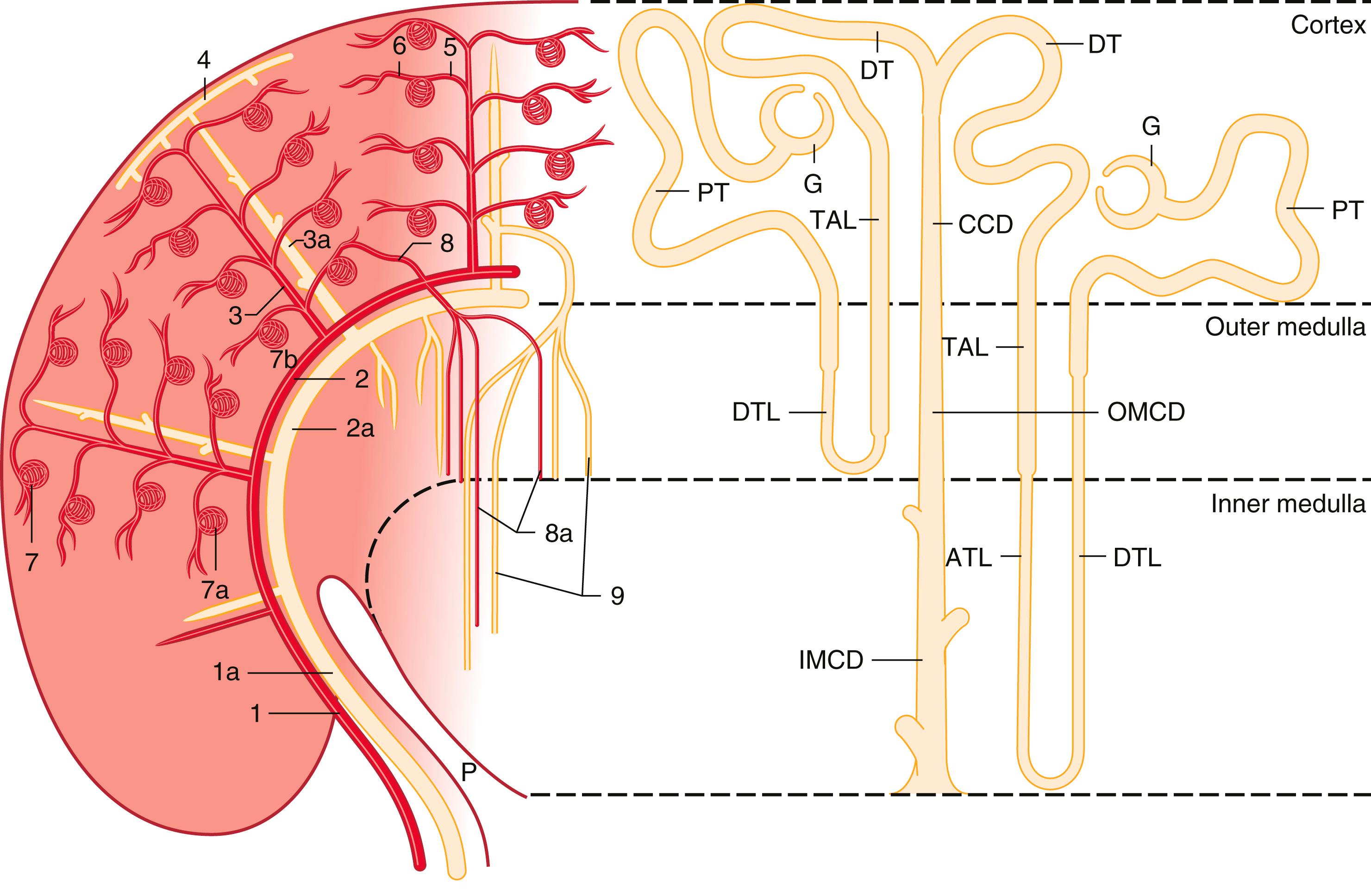
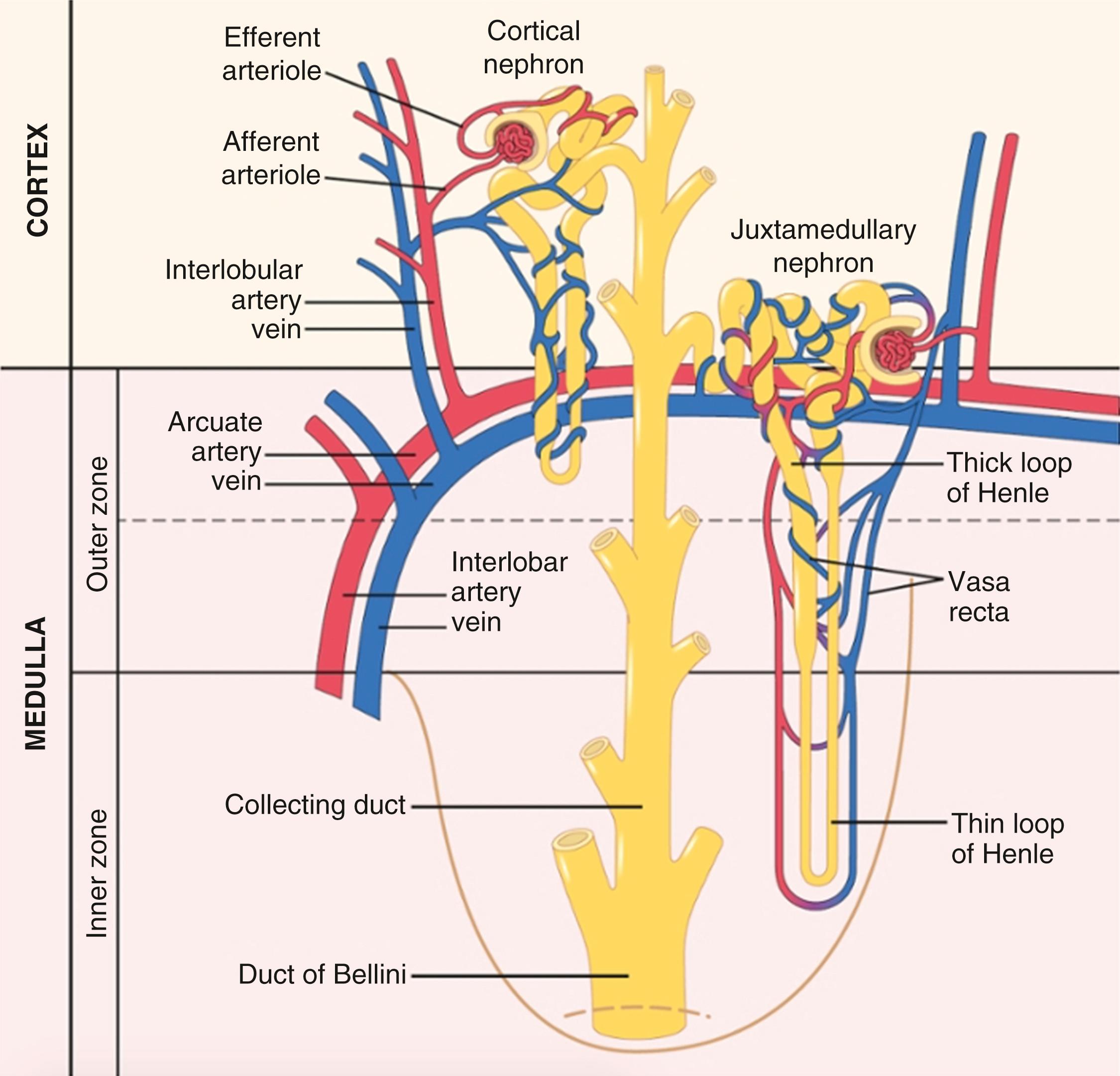
The kidney is divided into an outer layer, the cortex, which receives 85% to 90% of the renal blood flow (RBF), and an inner medulla (see Fig. 17.1 ). In the cortex are glomeruli (see Figs. 17.2 and 17.3 ), tufts of capillaries originating from afferent arterioles. The glomerular capillary endothelial cells have fenestrations that are barriers to red blood cells but allow the transit of plasma proteins and smaller molecules ( Fig. 17.4 ). Their glycocalyx is an anionic barrier that repels large macromolecules and albumin. Knowledge of this is through experimental studies and diseases where albuminuria is seen after alteration of anionic sites in the glomerular basement membrane (GBM). During development, these capillaries invaginate epithelial cells to form tufts of visceral epithelial cells with footlike morphologies called podocytes that are rich in actin cytoskeletons. These podocytes anchor to the GBM, closely interdigitate, and envelope the renal capillaries ( Fig. 17.5 ). A thin membrane called the slit diaphragm has an ultrastructural zipper-like complex that spans the space between each of the foot processes of the podocytes. Additional epithelial cells and their extravascular matrix make up the parietal epithelium that lines a pouch-like cistern, called Bowman space, which is the beginning of the renal tubular system.
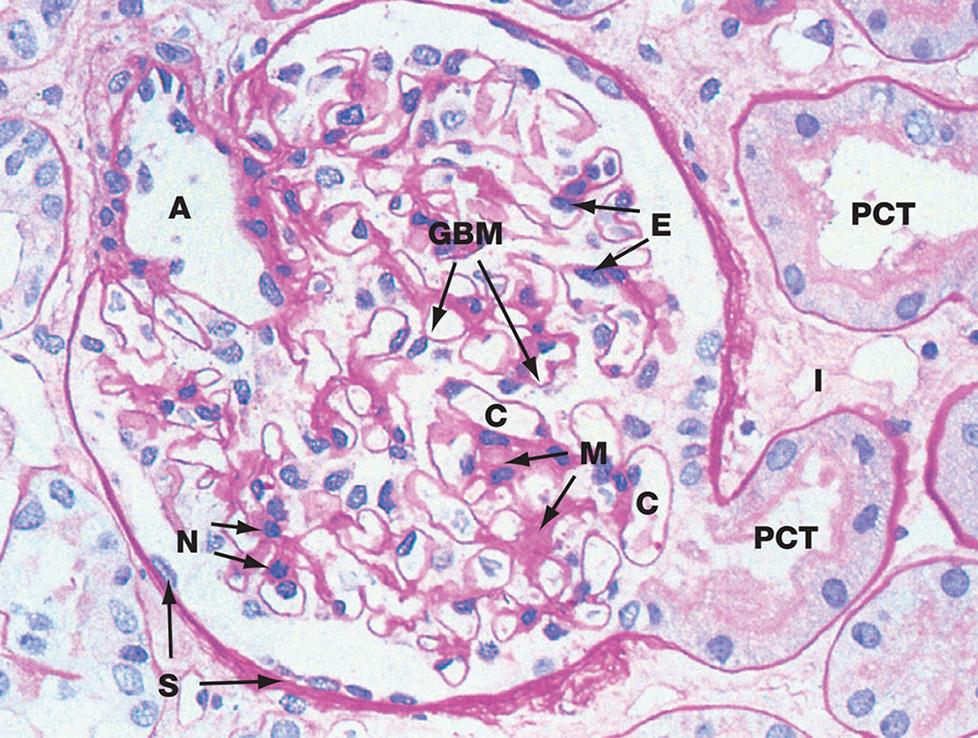
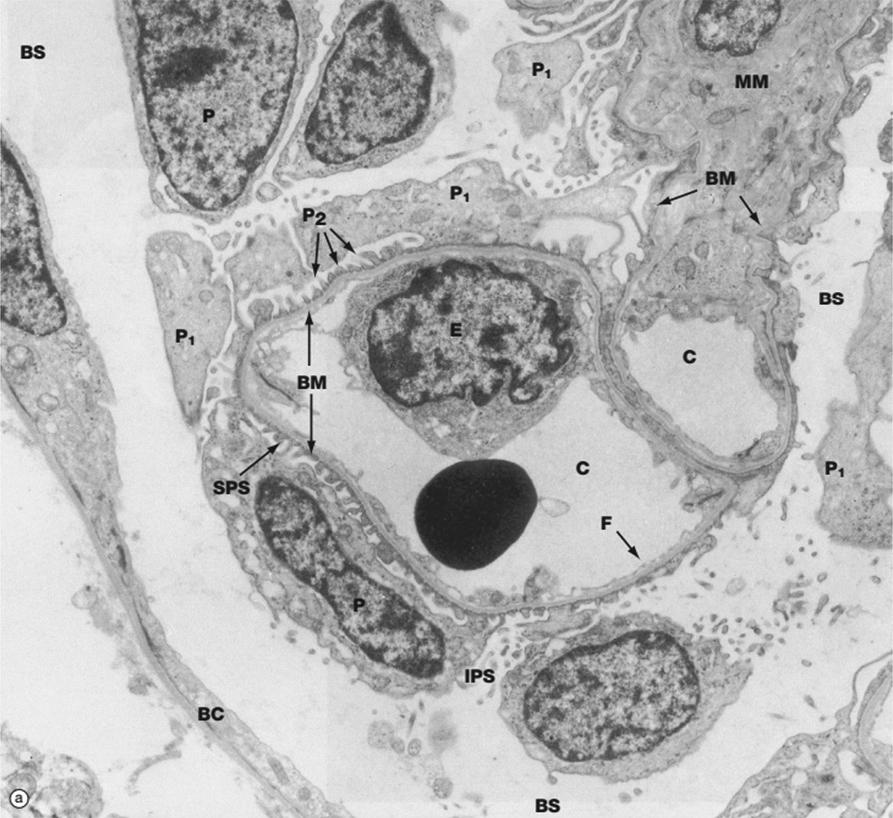
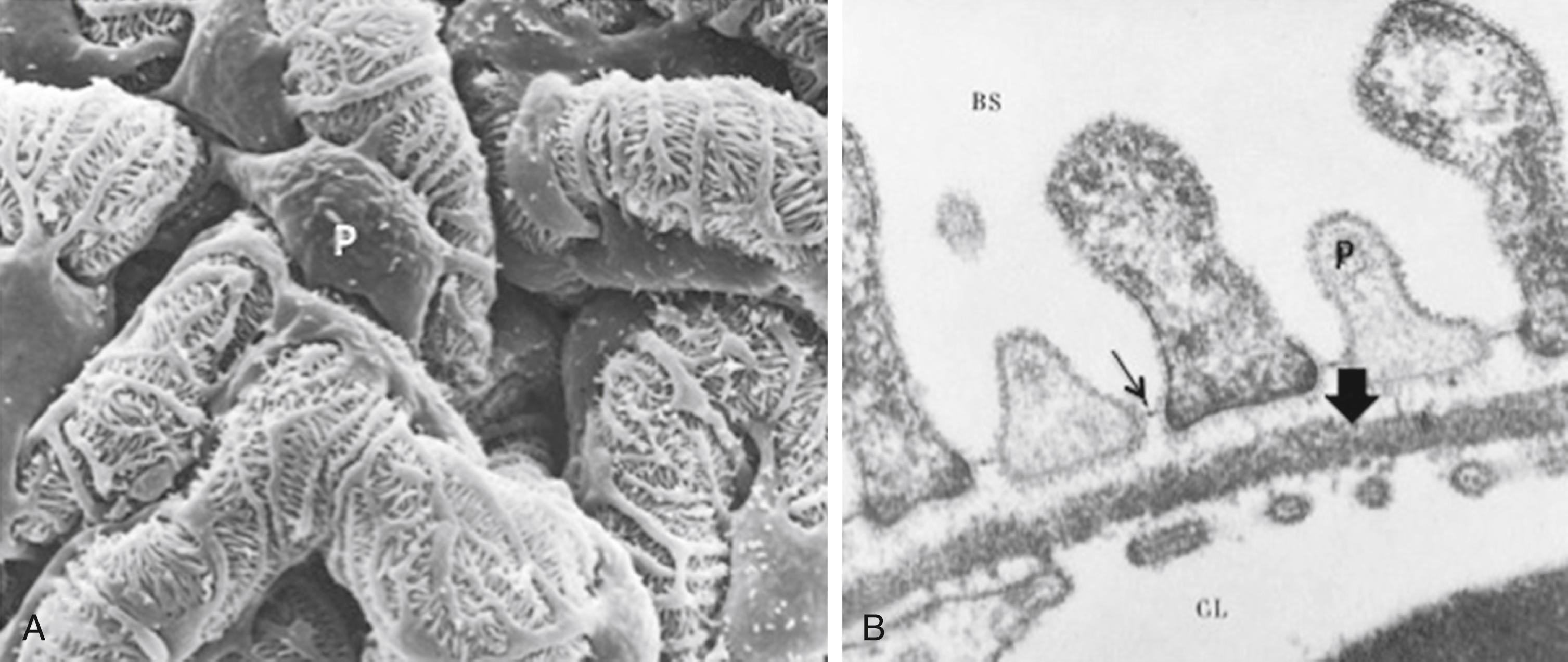
The vasculature of the kidney is unique in that it has two capillary beds. Upon leaving the glomerulus, the glomerular capillary then forms the efferent artery that in turn leads to an anastomosing network of 10 to 25 long peritubular capillaries called vasa recta. The vasa recta are close around the ascending limb of the loop of Henle before anastomosis into veins that leave the kidney (see Fig. 17.2 ).
The endothelial and epithelial cells synthesize proteins that are essential components of the filtration barrier of the kidney, the GBM (see Fig. 17.5 ). The GBM is rich in the anionic glycosaminoglycan heparin sulfate, Type IV collagen, and laminin. The epithelial cells maintain the integrity of this capillary bed by producing several key molecules including vascular endothelial growth factor and families of signaling proteins and receptors. The transmembrane protein nephrin supports the integrity of the slit pore diaphragms and its maintenance is dependent on the endocytosis of slit diaphragm proteins and plasma membrane components. The interplay between the foot processes of the podocytes, slit diaphragms, and organization of the actin intracellular scaffolds is centered on nephrin and related proteins. The functions of these numerous factors are often elucidated in experiential studies when found as etiologies of renal disease.
The kidneys receive 20% of the total cardiac output but extract relatively little oxygen. The renal arteriovenous oxygen difference is only 1.5 mL/dL. However, there is marked dissimilarity between the renal cortex and medulla with regard to blood flow, oxygen delivery, and oxygen consumption ( Table 17.1 ). The medulla receives only 6% of the RBF and has an average oxygen tension (PO 2 ) of 8 mm Hg. Thus, severe hypoxia could develop in the medulla despite a relatively adequate total RBF; the metabolically active medullary thick ascending loop of Henle (mTAL) is particularly vulnerable.
| Cortex | Medulla ∗ | |
|---|---|---|
| Percentage of renal blood flow | 94 | 6 |
| Blood flow (mL/min/g) | 5.0 | 0.03 |
| PO2 (mm Hg) | 50 | 8 |
| O2 extraction ratio (VO2/DO2) | 0.18 | 0.79 |
∗ The renal medulla receives only a small fraction of the total renal blood flow, and flow rates are extremely slow. As a result, the tissue oxygen tension is extremely low, and the medulla extracts almost 80% of the oxygen delivered to it. A very mild reduction in total and cortical renal blood flow may therefore induce ischemia and hypoxia in the renal medulla. DO 2 , Oxygen delivery; O 2 , oxygen; PO 2 , oxygen tension; VO 2 , oxygen consumption. Data from Brezis M, Rosen S, Epstein F. The pathophysiological implications of medullary hypoxia. Am J Kidney Dis . 1989;13:253–258.
The terminology of the renal tubular system is based on morphology as seen with light microscopy. The system begins with the proximal convoluted tubule (PCT) that starts as a continuation of the parietal epithelium of the nephron (see Fig. 17.3 ). A high density of mitochondria and the extensive surface area of the apical (referred as the brush border) and basilar cell membranes mark the renal tubules and indicate high-energy requirements. In normal kidneys, 80% of the energy is required for Na + /K + -ATPase that maintains the osmotic gradient needed for the resorption of filtered molecules ( Fig. 17.6 ). In spite of this high-energy demand, the tubular system is supplied by only 10% to 15% of the RBF and is a key etiology for acute tubular necrosis after hypotension (see Chapter 42 ).
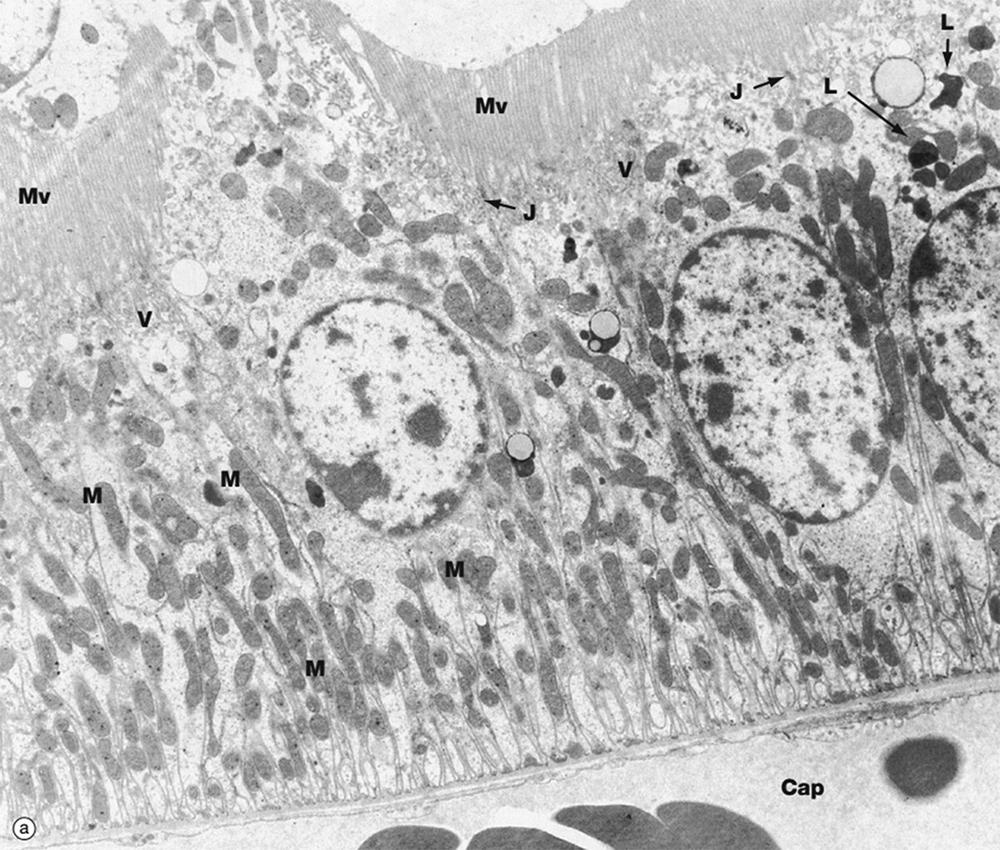
A distal short straight length of the proximal tubule leads to the thinner epithelium of the descending thin limb of the loop of Henle. This makes a hairpin 180-degree turn to ascend toward the cortex and eventually becomes the medullary thick ascending limb of the loop of Henle (mTAL) and distal convoluted tube (see Fig. 17.2 ). Seventy to 80% of nephrons begin in the cortex and have short loops of Henle that enter only the outer margin of the medulla. The remaining juxtamedullary nephrons start at the corticomedullary junction and have elongated loops of Henle that descend into the most distal extent of the medulla. At the end of the distal tubule is the juxtaglomerular apparatus that is comprised of specialized epithelial cells, called the macula densa (by virtue of light microscopic image), cells of the afferent glomerular arteriole, and mesangial cells ( Fig. 17.7 ). The juxtaglomerular apparatus is essential for the maintenance of blood pressure, as described later. The most distal end of the nephron is the collecting duct that empties the ultrafiltrate into the renal pelvis and then the ureters.
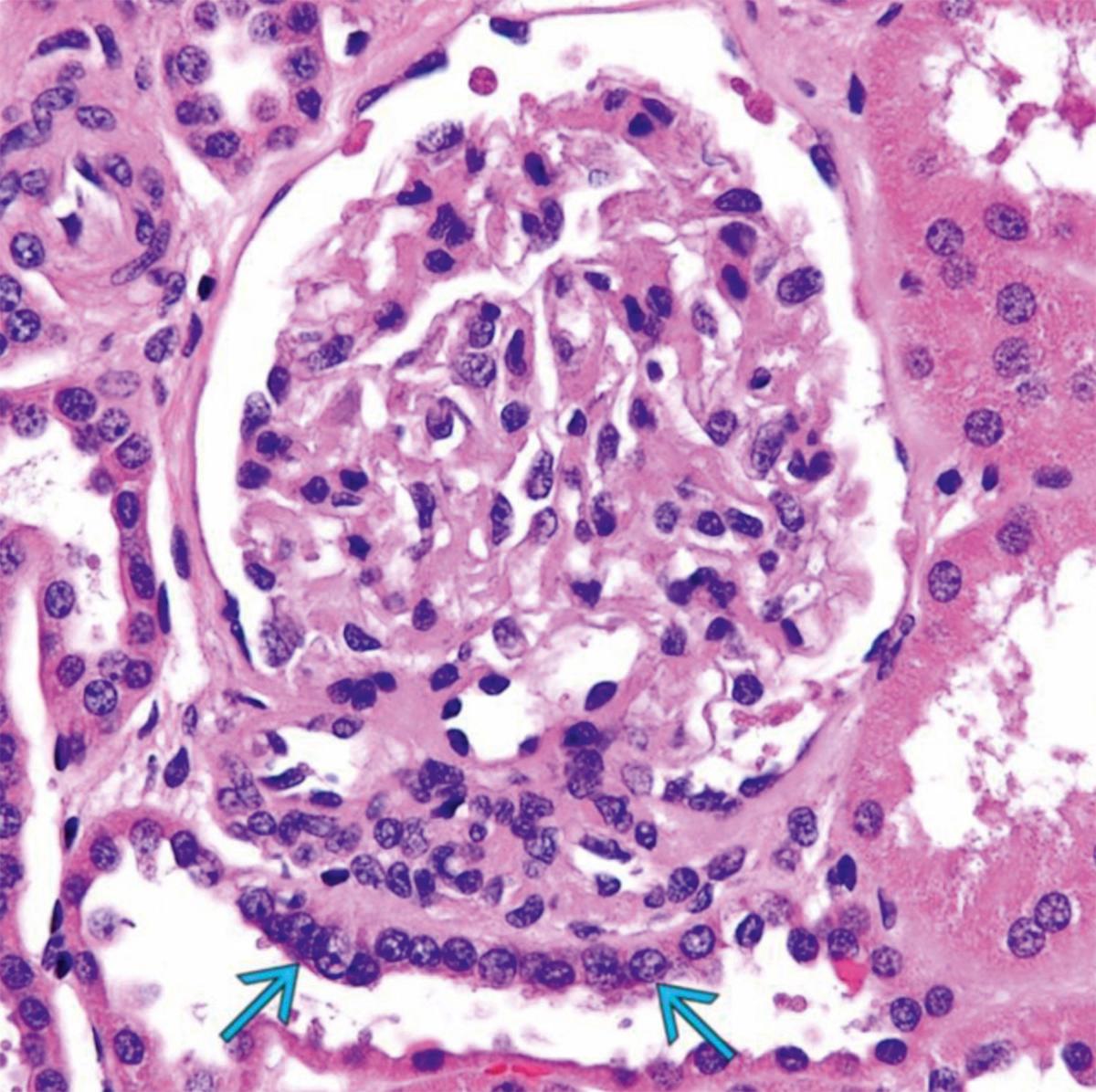
Urine is formed by the interaction of three processes: glomerular filtration, tubular reabsorption, and tubular secretion.
The formation of the glomerular filtrate is dependent on the balance of Starling forces regulating fluid flux across the filtration barrier. Central to this process is the pressure difference between the afferent and efferent arteries ( Fig. 17.8 ). The hydrostatic pressure in the glomerular capillaries is 60 mm Hg, which is three times higher than in most capillary beds. This pressure difference drives plasma across the endothelial and epithelial filtration barriers ( Table 17.2 ). A delicate balance in pressure maintenance is necessary because reduced pressures will decrease filtration, as increased pressures may cause renal damage. The glomerular filtration rate (GFR) depends upon the glomerular capillary pressure that is opposed by the hydrostatic pressure in Bowman space and the colloid osmotic pressure within the glomerular capillaries ( Figs. 17.8 and 17.9 ). In healthy patients, the colloid osmotic pressure in Bowman space is negligible, since the GBM restricts the passage of proteins. The normal GFR is about 180 L/day.
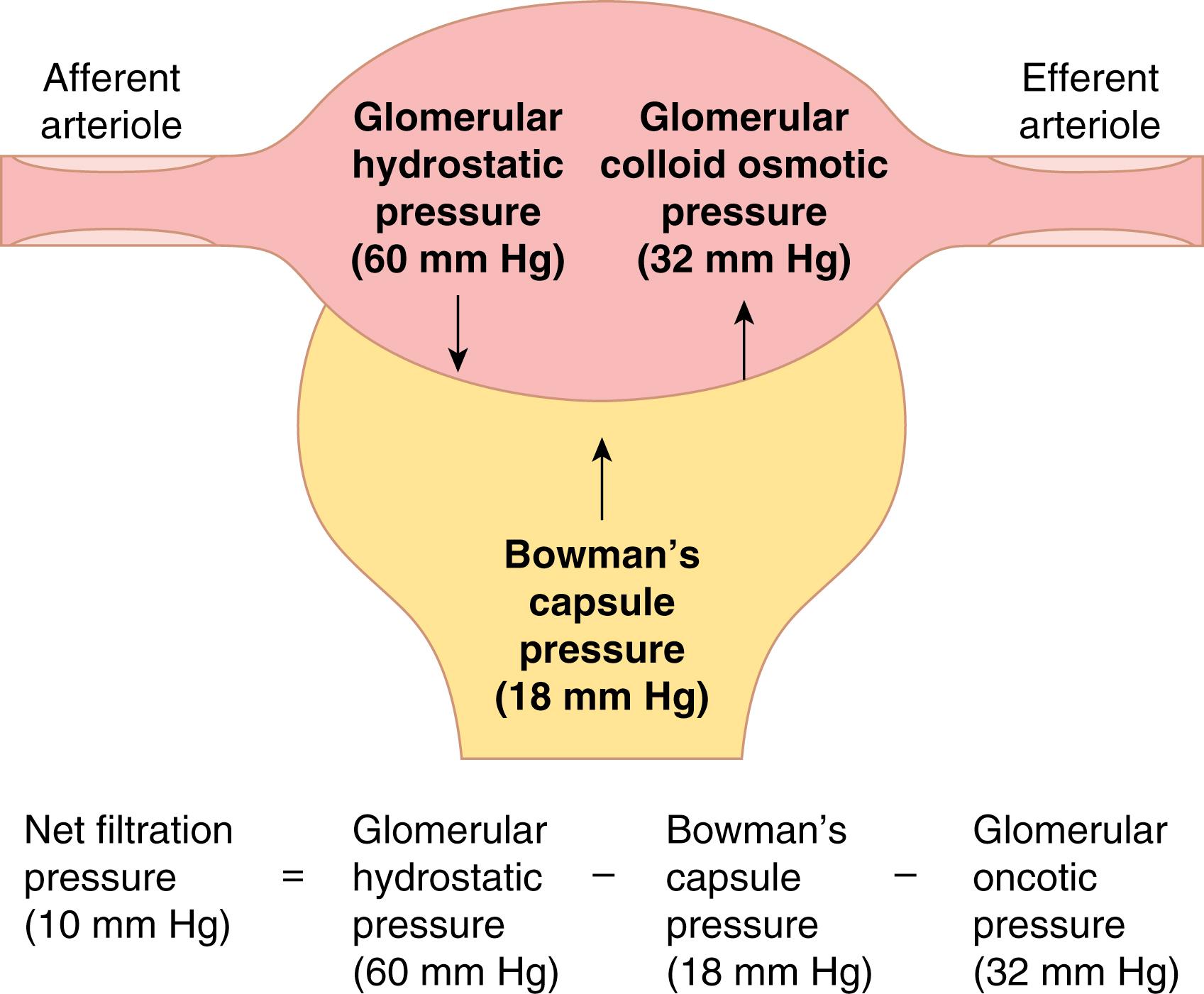
| Vessel | Pressure in Vessel (mm Hg) | Percent of Total Renal Vascular Resistance | |
|---|---|---|---|
| Beginning | End | ||
| Renal artery | 100 | 100 | ≈0 |
| Interlobar, arcuate, and interlobular arteries | ≈100 | 85 | ≈16 |
| Afferent arteriole | 85 | 60 | ≈26 |
| Glomerular capillaries | 60 | 59 | ≈1 |
| Efferent arteriole | 59 | 18 | ≈43 |
| Peritubular capillaries | 18 | 8 | ≈10 |
| Interlobar, arcuate, and interlobular veins | 8 | 4 | ≈4 |
| Renal vein | 4 | ≈4 | ≈0 |
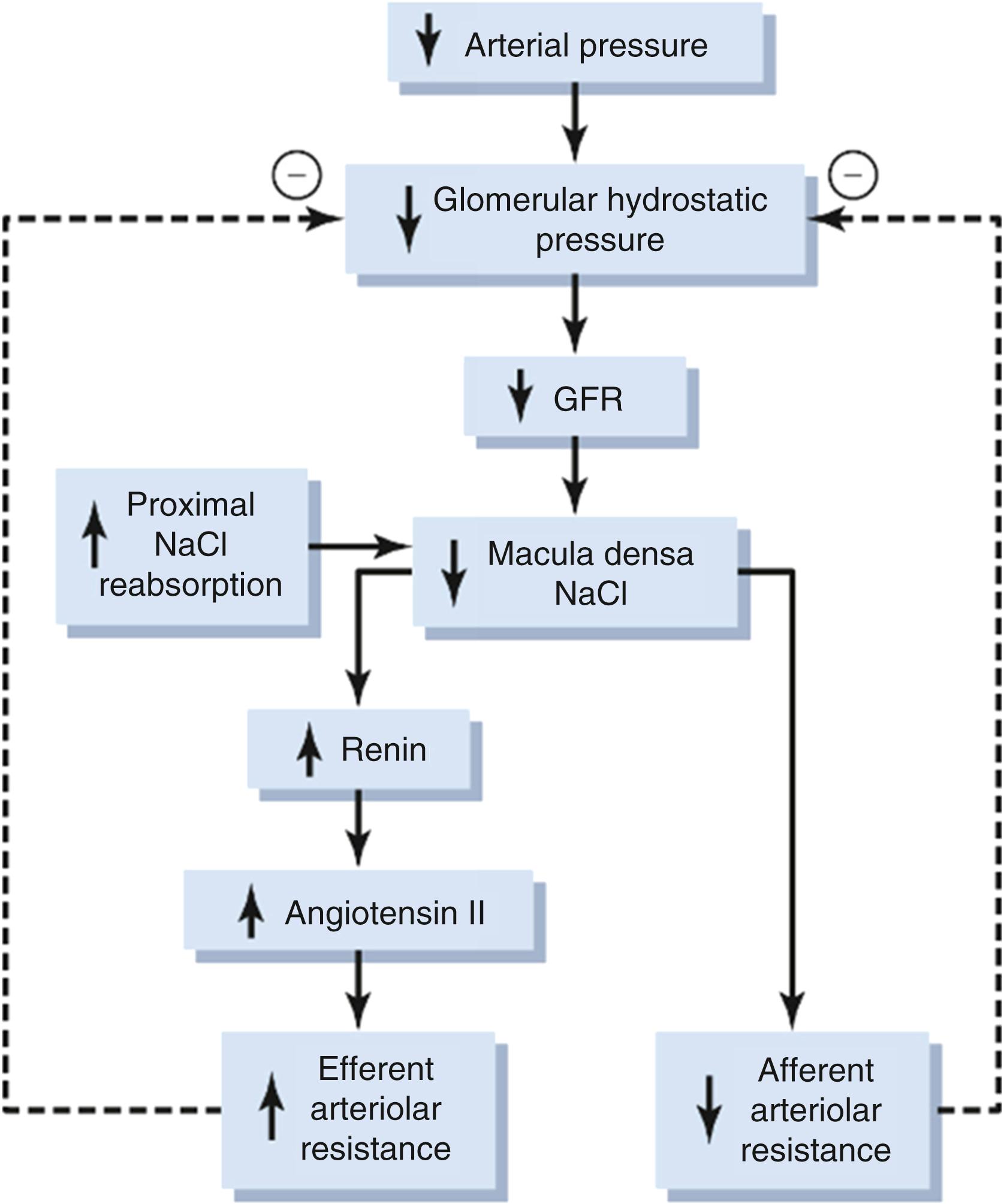
Control of this glomerular capillary pressure is exquisite. Hormones, peptides, and autacoids interact with receptors in the kidney to assure maintenance of RBF and GFR ( Fig. 17.10 ).
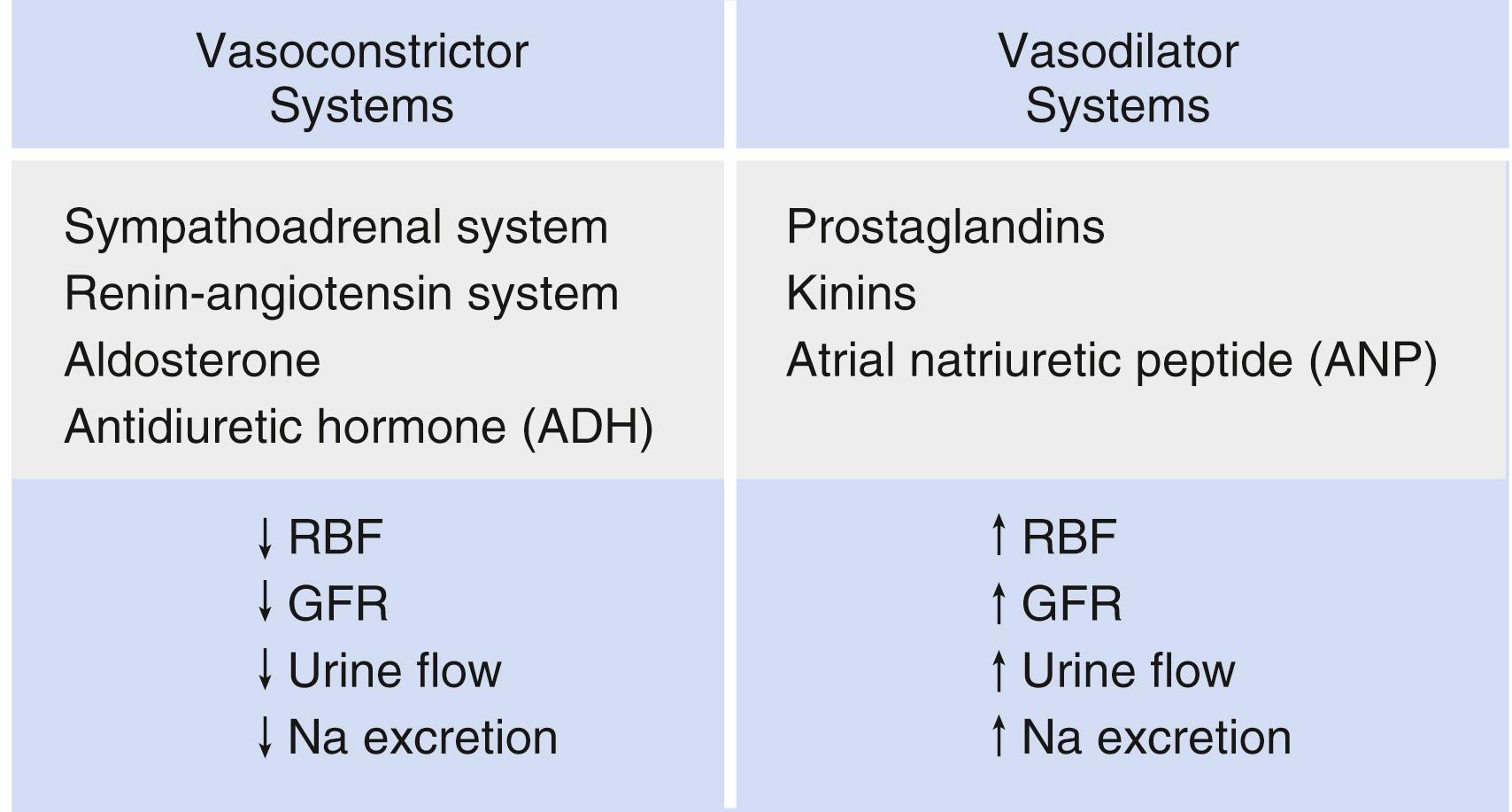
The vascular myocytes of afferent and efferent arterioles have the pressure-dependent ability to contract or relax. This prevents increased diuresis, appropriately called pressure diuresis, when the blood pressure is elevated. Mild α-adrenergic stimulation constricts the efferent arteriole that preserves GFR ( Fig. 17.11 ). Severe α-adrenergic activity decreases the filtration fraction by constricting the afferent and efferent arterioles to prevent a flow-induced decrease in GFR. This is the reason norepinephrine administration during sepsis may preserve diuresis. This is important to understand during shock, when the endogenous adrenergic response or the use of α agonists may worsen renal hypoperfusion and decrease the GFR. The kidney is relatively devoid of β2 receptors, so epinephrine release induces predominant vasoconstriction through α receptor or angiotensin activation.
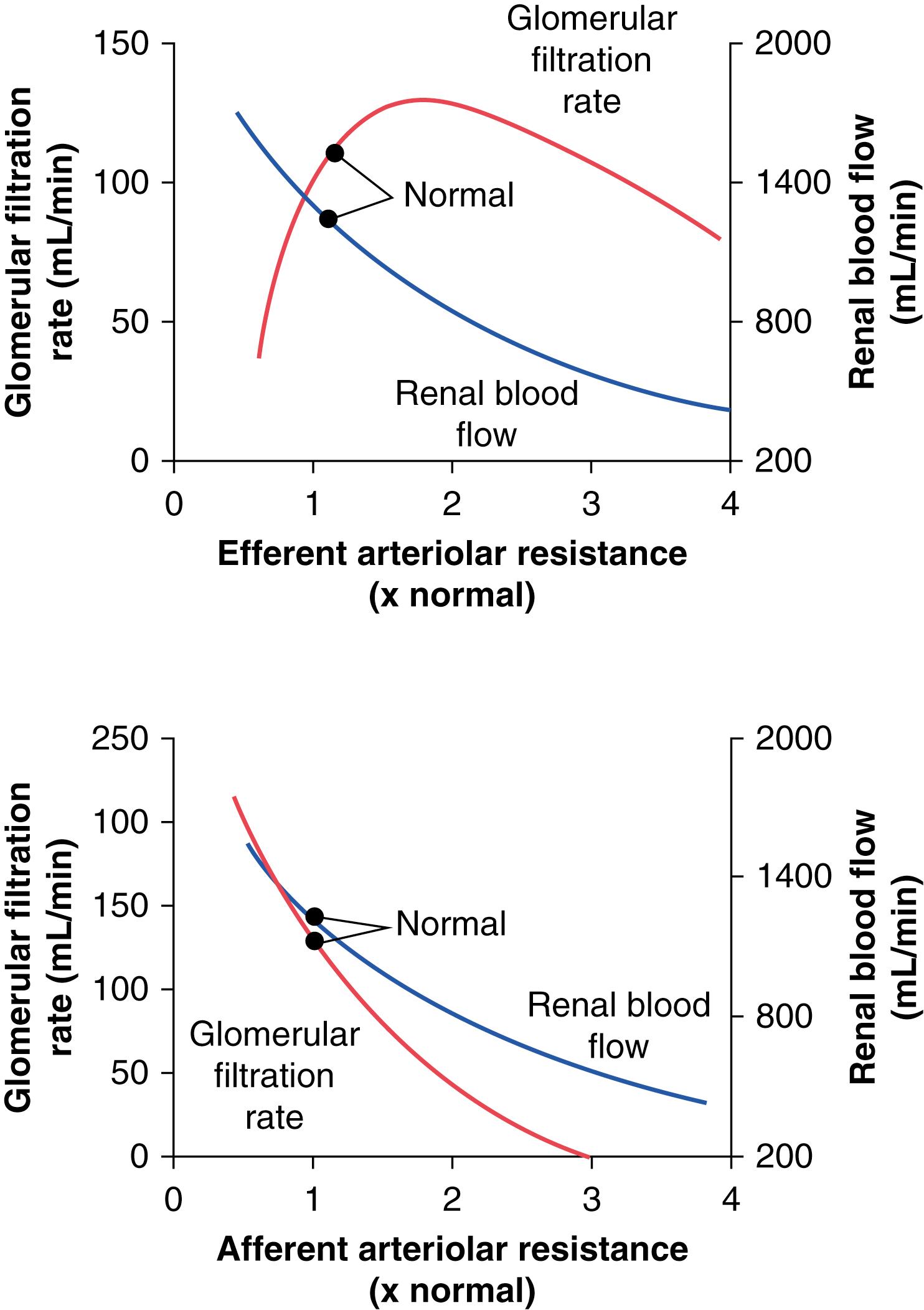
Adrenergic stimulation of the juxtaglomerular apparatus releases the enzyme renin from the cells of the macula densa and principal cells of the collecting ducts. Renin, more appropriately called angiotensinogenase, converts the hepatic synthesized glycopeptide angiogensinogen to angiotensin I. Angiotensin-converting enzymes (ACEs) are present in diverse cell types, including leukocytes and smooth muscle. The vascular endothelial cells of the kidney and lung are the major source of ACE that converts angiotensin I to angiotensin II.
Angiotensin II stimulates two pathways that have opposing effects ( Fig. 17.12 ). The principal receptor is AT 1 that is found on the luminal epithelial surface of the proximal tubular cell (PTC), mTAL, macula densa, distal tubules, and collecting ducts. The angiotensin II-AT 1 interaction serves to maintain systemic blood pressure through vasoconstriction, and enhancement of tubular transport mechanisms to reabsorb sodium and water. The binding of angiotensin II to “non-classical” receptors such as AT 7 opposes these actions and causes vasodilatation through nitric oxide (NO) and prostaglandin-mediated natriuresis, diuresis, and reduced oxidative stress.
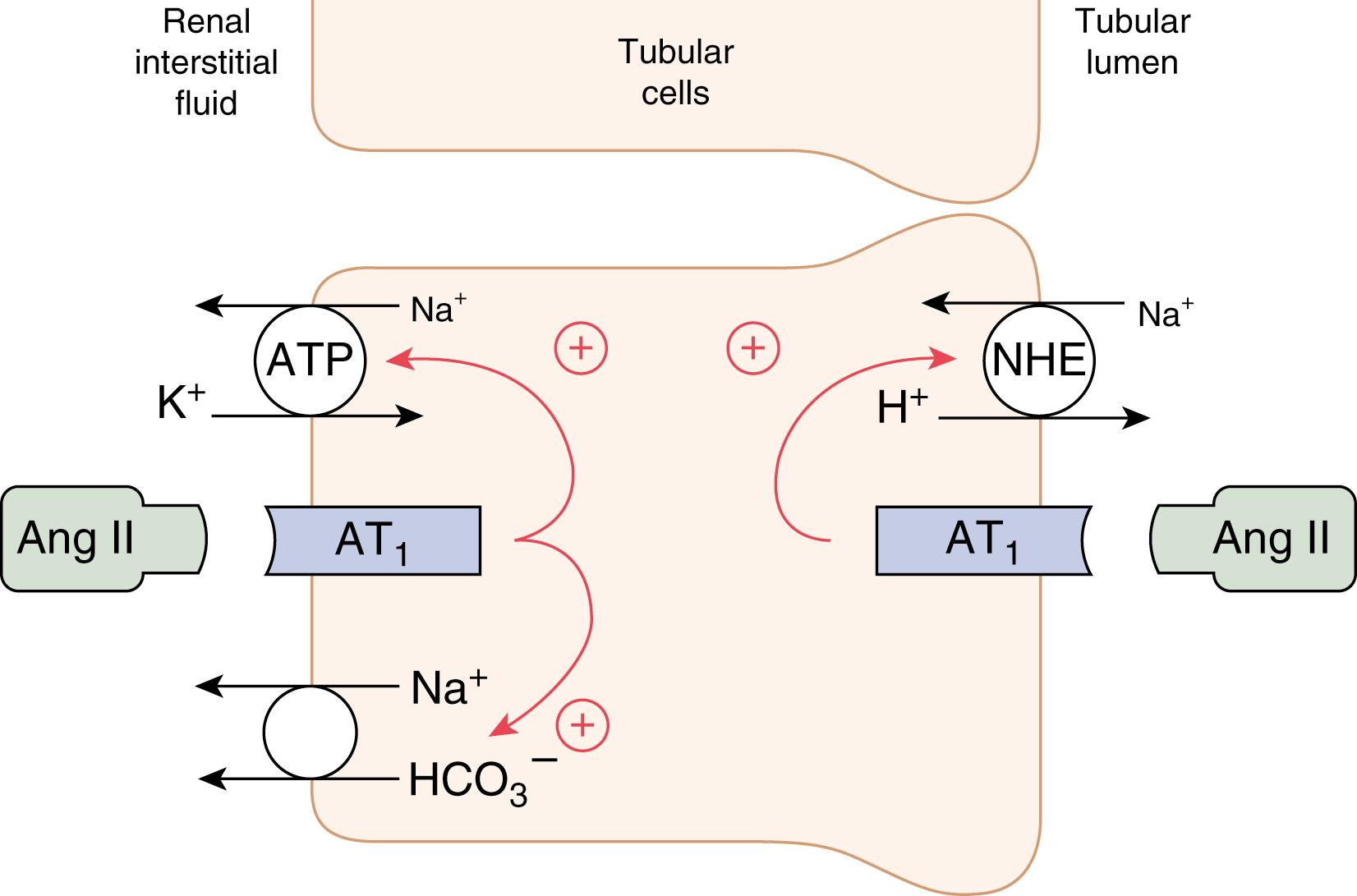
Angiotensin II is a potent vasoconstrictor of efferent arterioles, which increases the pressure difference and enhances filtration. This maintains the glomerular filtration fraction in the face of mild to moderate decreases in RBF or perfusion pressure that may result from hypovolemia or systemic hypotension. Angiotensin II promotes systemic vasoconstriction at about one tenth of its renal effect. Renin secretion is stimulated by hypovolemia from hemorrhage, diuresis, or sodium loss/restriction and by reductions in perfusion as seen with positive pressure ventilation, congestive heart failure, sepsis, or cirrhosis with ascites. Angiotensin II feeds back to the juxtaglomerular apparatus to inhibit renin secretion. It also stimulates phospholipase A 2 to trigger the synthesis of vasodilatory prostaglandins.
Intrarenal prostaglandins play an important role in endogenous renal protection by vasodilating juxtamedullary blood vessels and maintaining inner cortical blood flow. Prostaglandins are called autacoids because, unlike true hormones, they are produced in minute amounts and have a local, evanescent action. Because their structure is based on a 20-carbon fatty acid, they are also referred to as eicosanoids, after eicosa , the Greek word for the number 20.
Phospholipase A 2 resides in the inner lipid layer of the cell membrane and controls prostaglandin production through its formation of the prime precursor, arachidonic acid. It is stimulated by ischemia, hypotension, norepinephrine, angiotensin II, and arginine vasopressin (AVP). Thus, the factors that induce and mediate the stress response simultaneously activate prostaglandins, which defend the kidney against their actions. Cyclooxygenase-1 acts on arachidonic acid to form the vasodilator prostaglandins that include PGD2, PGE2, and PGI2 (prostacyclin). Vasodilation is through activation of cyclic adenosine monophosphate (cAMP) to oppose the action of catecholamines, angiotensin II, and AVP. Prostaglandins may be particularly important in decreasing the vasoconstrictor activity of angiotensin II on the afferent arteriole and mesangial cells. Drugs that inhibit prostaglandin synthesis, such as nonsteroidal anti-inflammatory agents, can upset this compensatory mechanism and result in medullary ischemia.
Kinins act directly as vasodilators, as well as stimulate phospholipase A 2 , prostacyclin production, and endothelial cell NO formation. Kinins are produced by cleavage of kininogen by the serine protease kallikrein. Over 90% of renal kallikrein is produced by the distal convoluted tubules in the cortex with decreased concentrations from outer to inner zones. Renal kininase, which controls the level of bradykinin, is inhibited by ACE inhibitors and is the reason for angioedema.
AVP, also known as antidiuretic hormone (ADH), is produced by the posterior pituitary, and its release is stimulated by hyperosmolality or hypovolemia. By far the most potent trigger for AVP release is systemic arterial hypotension, mediated by aortic and carotid baroreceptors. It overrides all other triggers, and plasma AVP may reach levels 10- to 1000-fold greater than normal. At these concentrations, AVP acts as a vasoconstrictor, especially in the outer renal cortex. It does so by stimulating the V 1A receptor that exists on vascular smooth muscle, glomerular mesangial cells, and the vasa recta and promotes vasoconstriction through the phosphatidylinositol pathway. AVP maintains effective glomerular filtration pressure because it is an extremely potent constrictor of the efferent arteriole, and unlike catecholamines and angiotensin, it has little effect on the afferent arteriole, even at high plasma levels. The binding to V 2 receptors on the medullary collecting ducts stimulates adenylate cyclase to form cAMP that enhances aquaporin-2 channels of the principal cells to increase water reabsorption ( Fig. 17.13 ). Anesthetics have little direct effect on AVP secretion, except via the changes that they induce in arterial blood pressure, venous volume, and serum osmolality. Surgical stimulation is a major stimulus to AVP secretion. This stress response, whether mediated by pain or by intravascular volume changes, is profound and lasts at least 2 to 3 days after the surgical procedure.
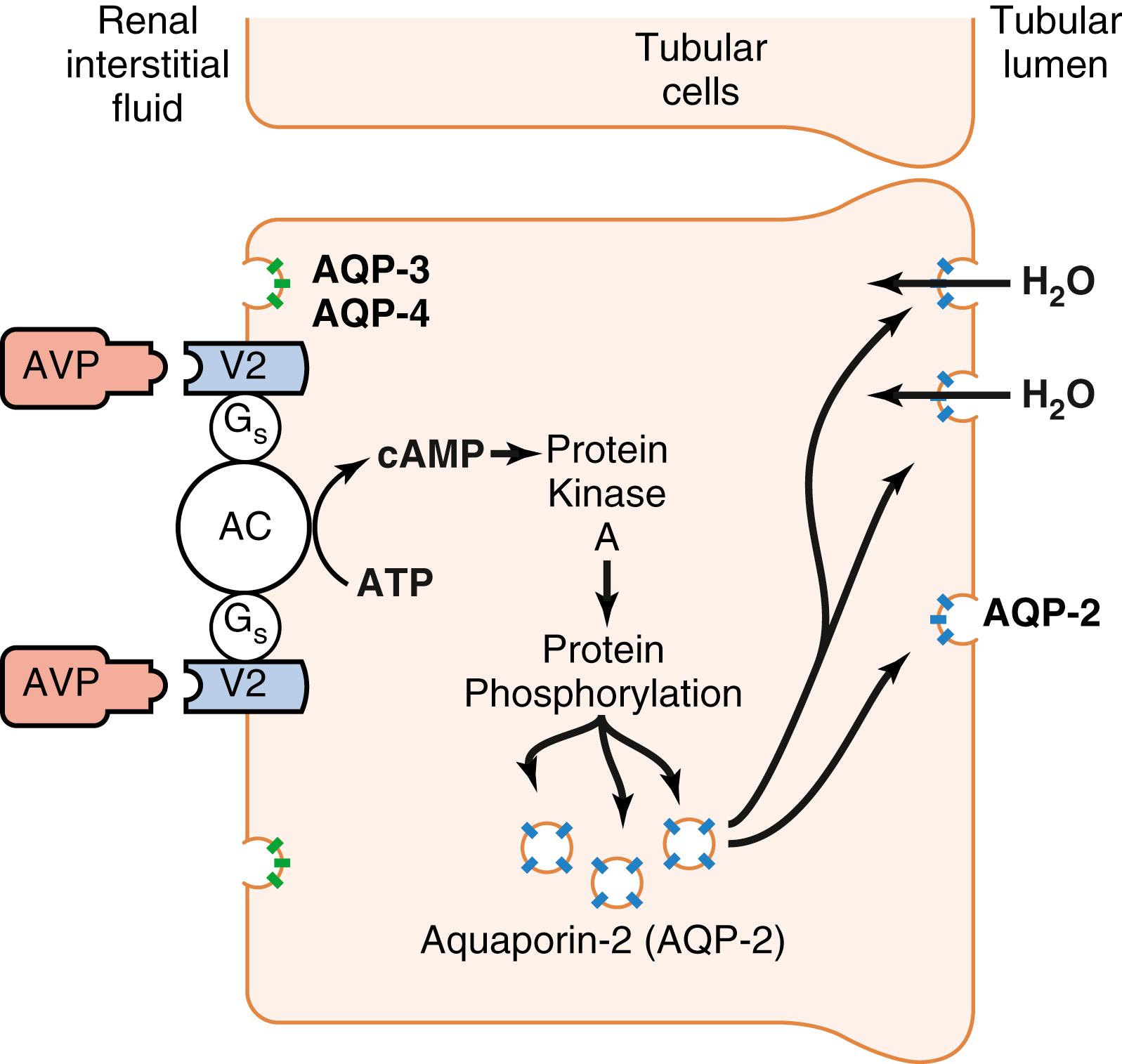
Natriuretic peptides dilate vascular smooth muscle through activation of cyclic guanosine monophosphate by blocking the phospholipase C-linked receptors to the actions of norepinephrine and angiotensin II. Atrial natriuretic peptide (ANP) is released from atrial myocytes in response to atrial wall stretch and increased atrial volume, brain (B-type) natriuretic peptide is released in response to cerebral ventricle stretch, and C-type is released from the endothelium of major blood vessels. Urodilatin is secreted by the epithelium of the distal tubules and collecting ducts in response to increases in mean arterial pressure and blood volume.
The natriuretic peptides cause prompt, sustained increases in GFR and glomerular filtration fractions even when RBF is not increased or when arterial pressure is decreased. They promote afferent arteriolar dilatation with or without efferent arteriolar constriction, antagonize endothelin (the endogenous vasoconstrictor peptide produced by vascular endothelial cells), inhibit renin secretion, and decrease angiotensin-stimulated aldosterone. These peptides also inhibit the release of aldosterone in the adrenal cortex and block its actions at the distal tubules and collecting ducts. Moreover, they inhibit the secretion of AVP through their effects on the brain and pituitary, which can lead to an enhanced diuresis. NaCl is resorbed, and diuresis is promoted. These actions are important in oliguric patients (such as those with acute renal failure and chronic renal failure) to increase urine output.
Aldosterone is a steroid hormone secreted by the zona glomerulosa of the adrenal cortex in response to hyperkalemia or hyponatremia. Angiotensin II and adrenocorticotropic hormone also trigger its release. It acts at the thick ascending limb of the loop of Henle, the principal cells of the distal tubule, and the collecting duct to increase active absorption of sodium and passive absorption of water, culminating in an expanded blood volume. Sodium retention in vessel walls appears to enhance their response to vasoconstrictor agents. In contrast to the immediate sympathetic angiotensin II response to hypovolemia, there is a delay of about 1 to 2 hours from the secretion of aldosterone to its action on sodium reabsorption.
Aldosterone forms a complex with a receptor at the cell membrane in the principal cells of the distal tubule ( Fig. 17.14 ). The aldosterone-receptor complex travels to the cell nucleus, where it induces cytoplasmic transcription of messenger ribonucleic acid. This fosters synthesis of proteins that form sodium channels in the apical cell membrane and enhance the Na + /K + /ATPase pump in the basolateral cell membrane. Sodium is transported from the tubular fluid into the peritubular capillary in exchange for potassium. Long-standing stimulation of aldosterone secretion, characteristically induced by the intravascular volume depletion of chronic ascites, culminates in potassium depletion and hypokalemic alkalosis.
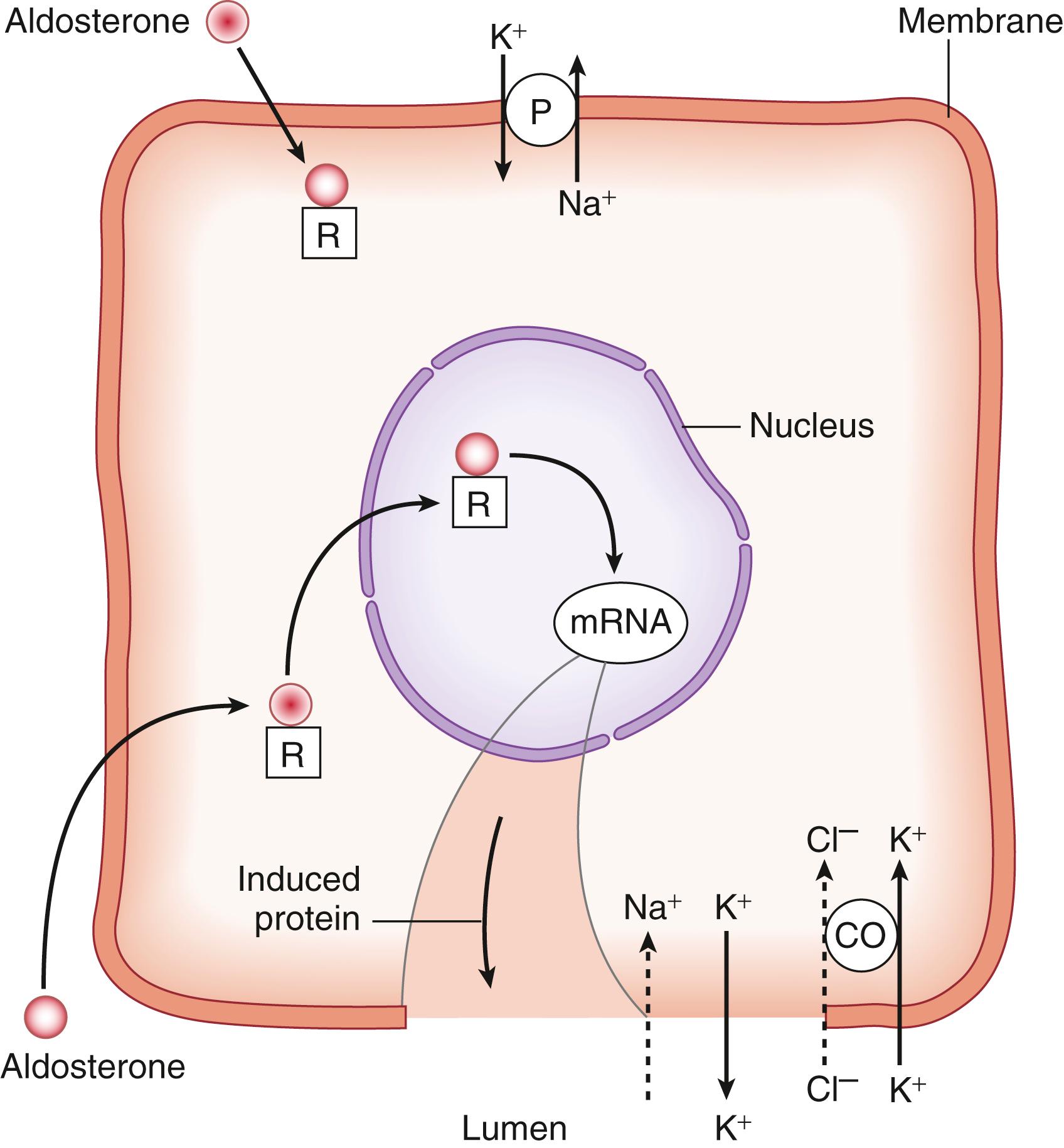
Become a Clinical Tree membership for Full access and enjoy Unlimited articles
If you are a member. Log in here